Three-Dimensional Imaging of Circular Array Synthetic Aperture Sonar for Unmanned Surface Vehicle
Abstract
:1. Introduction
2. CASAS System
2.1. CASAS Configuration
2.2. CASAS Parameters and Signal Model
2.3. CASAS Data Acquisition
3. CASAS Three-Dimensional Image Processing
3.1. Signal Calibration
3.2. Scattering Coefficient Reconstruction along the Height Direction
| Algorithm 1: Procedure of SBL to Reconstruction Imaging along the height direction |
| Input: |
| Matrix , image vector in height direction; Initial hyperparameter , parameter c and d; Convergence value ε; |
| Output: |
| Mean ; covariance ; 1: Begin |
| 2: Initialize input parameter, step j = 1; 3: do 4: computer and by Equation (18); 5: Update and ; 6: Calculate hyperparameter by Equation (22), j = j + 1; 7: if 8: 9: end do 10: return 11: ,. |
| 12: End |
3.3. D Imaging Reconstruction Procedure
3.4. Point Spread Function of CASAS
4. Simulation and Experiment
4.1. Simulation Setup and Results
4.2. Experiment Setup and Results
5. Conclusions
Author Contributions
Funding
Institutional Review Board Statement
Informed Consent Statement
Data Availability Statement
Acknowledgments
Conflicts of Interest
References
- Hansen, R.E.; Callow, H.J.; Sæbø, T.O.; Synnes, S.A.V. Challenges in seafloor imaging and mapping with synthetic aperture sonar. IEEE Trans. Geosci. Remote Sens. 2011, 49, 3677–3687. [Google Scholar] [CrossRef]
- Hansen, R.E. Introduction to Synthetic Aperture Sonar, Sonar Systems; Kolev, N.Z., Ed.; Intech: Triangle Park, NC, USA, 2011; pp. 3–7. [Google Scholar]
- Hayes, M.P.; Gough, P.T. Synthetic Aperture Sonar: A Review of Current Status. IEEE J. Ocean. Eng. 2009, 34, 207–224. [Google Scholar] [CrossRef]
- Marston, T.M.; Kennedy, J.L. Volumetric Acoustic Imaging via Circular Multipass Aperture Synthesis. IEEE J. Ocean. Eng. 2016, 41, 852–867. [Google Scholar] [CrossRef]
- Hawkins, D.W. Synthetic Aperture Imaging Algorithms: With Application to Wideband Sonar. Ph.D. Thesis, University of Canterbury, Christchurch, New Zealand, 1996. [Google Scholar]
- Bülow, H.; Birk, A. Synthetic Aperture Sonar (SAS) without Navigation: Scan Registration as Basis for Near Field Synthetic Imaging in 2D. Sensors 2020, 20, 4440. [Google Scholar] [CrossRef] [PubMed]
- Griffiths, H.D.; Rafik, T.A.; Meng, Z.; Cowan, C.F.; Shafeeu, H.; Anthony, D.K. Interferometric synthetic aperture sonar for high-resolution 3D mapping of the seabed. Proc. Inst. Electr. Eng.—Radar Sonar Navig. 1997, 144, 96–103. [Google Scholar] [CrossRef] [Green Version]
- Sæbø, T.O.; Hansen, R.E.; Austeng, A. Synthetic aperture sonar tomography: A preliminary study. In Proceedings of the 10th European Conference on Synthetic Aperture Radar, Berlin, Germany, 3–5 June 2014. [Google Scholar]
- Jideani, J.; Wilkinson, W. Air-based synthetic aperture sonar tomography using compressive sensing. In Proceedings of the 2014 IEEE International Ultrasonics Symposium, Chicago, IL, USA, 3–6 September 2014. [Google Scholar] [CrossRef]
- Ferguson, B.G.; Wyber, R.J. Application of acoustic reflection tomography. J. Acoust. Soc. Am. 2005, 117, 2915–2928. [Google Scholar] [CrossRef]
- Ferguson, B.G.; Wyber, R.J. Generalized Framework for Real Aperture, Synthetic aperture, and Tomographic Sonar Imaging. IEEE J. Ocean. Eng. 2009, 34, 225–238. [Google Scholar] [CrossRef]
- Marston, T.; Kennedy, J.; Marston, P. Coherent and semi-coherent processing of limited-aperture circular synthetic aperture (CSAS) data. In Proceedings of the OCEANS’11 MTS/IEEE KONA, Waikoloa, HI, USA, 19–22 September 2011; pp. 1–6. [Google Scholar]
- Tran, H.; Nguyen, B.; Melino, R.; Wood, S. A Detailed Study of Sonar Tomographic Imaging. Maritime Operations Division Electronic Warfare and Radar Division: Research Report AR-015-647; 2013. Available online: http://dspace.dsto.defence.gov.au/dspace/bitstream/dsto/10336/1/DSTO-RR-0394%20PR.pdf (accessed on 6 April 2022).
- Callow, H.; Hansen, R.; Synnes, S.; Saebo, T. Circular synthetic aperture sonar without a beacon. In Proceedings of the 3rd International Conference & Exhibition on Underwater Acoustic Measurements, Nafplion, Greece, 21–26 June 2009. [Google Scholar]
- Fan, W.; Kong, H.; Zhang, X. Simulation of circular synthetic aperture sonar imaging using TriKirch scattering model and experimental validation. In Proceedings of the OCEANS 2017, Aberdeen, UK, 19–22 June 2017; pp. 128–131. [Google Scholar]
- Goldman Lee, W. Principles of CT: Multi-slice CT. J. Nucl. Med. Technol. 2008, 75, 57–68. [Google Scholar] [CrossRef] [Green Version]
- Javier, D.; Francisco, J.; Rodríguez, T. Exploring computed tomography in ichnological analysis of cores from modern marine sediments. Sci. Rep. 2020, 10, 47–69. [Google Scholar]
- Pan, Y.; Shi, D.; Wang, H.; Chen, T.; Cui, D.; Cheng, X.; Lu, Y. Automatic opportunistic osteoporosis screening using low-dose chest computed tomography scans obtained for lung cancer screening. Eur. Radiol. 2020, 30, 4107–4116. [Google Scholar] [CrossRef] [Green Version]
- Hui, L.; Peifeng, M.; Min, C.H. Basic principles, Key technique and applications of tomographic SAR imaging. J. Geomat. 2015, 40, 2–6. [Google Scholar]
- Liao, Z.; He, B.; Quan, X. Potential of texture from SAR tomographic images for forest aboveground biomass estimation. Int. J. Appl. Earth Obs. Geoinf. 2020, 88, 2–8. [Google Scholar] [CrossRef]
- Rambour, C.; Denis, L.; Tupin, F.; Oriot, H.; Huang, Y. Urban surface reconstruction in SAR tomography by graph-cuts. Comput. Vis. Image Underst. 2019, 188, 102791. [Google Scholar] [CrossRef]
- Matteo, N.; Michele, M.; Paola, R.; Pau, P. Coherence-based SAR tomography for spaceborne applications. Remote Sens. Environ. 2019, 225, 107–114. [Google Scholar]
- Bi, H.; Zhang, B.; Hong, W. Matrix completion-based distributed compressive sensing for polarimetric SAR tomography. Sci. China Inf. Sci. 2015, 58, 1–3. [Google Scholar] [CrossRef]
- Pailhas, Y.; Petillot, Y.; Mulgrew, B. Increasing circular synthetic aperture sonar resolution via adapted wave atoms deconvolution. J. Acoust. Soc. Am. 2017, 141, 2623–2632. [Google Scholar] [CrossRef] [Green Version]
- Jermaine, L.K.; Timothy, M.M. Multipass and Non-Concentric Target Circular Synthetic Aperture Sonar (CSAS). Final Report. SERDP Project Number: MR-2439. January 2018. Available online: https://apps.dtic.mil/sti/pdfs/AD1065501.pdf (accessed on 6 April 2022).
- Marston, T.; Kennedy, J. Spatially variant autofocus for circular synthetic aperture sonar. J. Acoust. Soc. Am. 2021, 149, 4078–4093. [Google Scholar] [CrossRef]
- Jing, M.; Xiaoling, Z.; Ling, P.; Jun, S. PSF analysis and ground test results of a novel circular array 3-D SAR system. J. Radars 2018, 7, 770–776. [Google Scholar]
- Zhang, R.; Cao, S. 3D Imaging Millimeter Wave Circular Synthetic Aperture Radar. Sensors 2017, 17, 1419. [Google Scholar] [CrossRef]
- Plotnick, D.S.; Marston, P.L.; Marston, T.M. Fast nearfield to farfield conversion algorithm for circular synthetic aperture sonar. J. Acoust. Soc. Am. Exp. Lett. 2014, 136, EL61–EL66. [Google Scholar] [CrossRef]
- Hao, J.; Li, J. Three-Dimensional Imaging of Terahertz Circular SAR with Sparse Linear Array. Sensors 2018, 18, 2477. [Google Scholar] [CrossRef] [PubMed] [Green Version]
- Xu, G.; Yang, L.; Bi, G.; Xing, M. Enhanced ISAR imaging and motion estimation with parametric and dynamic sparse bayesian learning. IEEE Trans. Comput. Imaging 2017, 3, 940–952. [Google Scholar] [CrossRef]
- Tang, V.H.; Bouzerdoum, A.; Phung, S.L.; Tivive, F.H.C. A sparse bayesian learning approach for through-wall radar imaging of stationary targets. IEEE Trans. Aerosp. Electron. Syst. 2017, 53, 2485–2501. [Google Scholar] [CrossRef]
- Zhang, Y. Theory of Compressive Sensing via l1-Minimization: A Non-RIP Analysis and Extensions. J. Oper. Res. Soc. China 2013, 1, 79–105. [Google Scholar] [CrossRef] [Green Version]
- Romberg, J. Imaging via compressive sampling [introduction to compressive sampling and recovery via convex programming]. IEEE Signal Proc. Mag. 2008, 25, 14–20. [Google Scholar] [CrossRef]
- Zhang, Z.; Rao, B.D. Sparse signal recovery with temporally correlated source vectors using sparse Bayesian learning. IEEE J. Sel. Top. Signal Process. 2011, 5, 912–926. [Google Scholar] [CrossRef] [Green Version]
- Fienup, J.R.; Miller, J.J. Abberation correction by maximizing generalized sharpness metrics. J. Opt. Soc. Am. A Opt. Image Sci. 2003, 20, 609–620. [Google Scholar] [CrossRef] [PubMed]
- Kolman, J. Image Reconstruction and Restoration Using Constrained Optimization Algorithms. Ph.D. Thesis, Purdue University, West Lafayette, IN, USA, August 1996. [Google Scholar]
- Fienup, J.R. Synthetic-aperture radar autofocus by maximizing sharpness. Opt. Lett. 2000, 25, 221–223. [Google Scholar] [CrossRef] [PubMed]
- Ash, J. An autofocus method for backprojection imagery in synthetic aperture radar. IEEE Geosci. Remote Sens. Lett. 2012, 9, 104–108. [Google Scholar] [CrossRef]
- Peng, H.; Ruan, Z.; Long, F.; Simpson, J.H.; Myers, E.W. V3D enables real-time 3D visualization and quantitative analysis of large-scale biological image data sets. Nat. Biotechnol. 2010, 28, 348–355. [Google Scholar] [CrossRef] [Green Version]
- Peng, H.; Bria, A.; Zhou, Z.; Iannello, G.; Long, F. Extensible visualization and analysis for multidimensional images using Vaa3D. Nat. Protocols. 2014, 9, 193–208. [Google Scholar] [CrossRef] [PubMed]
- Peng, H.; Tang, J.; Xiao, H.; Bria, A.; Zhou, J.; Butler, V.; Zhou, Z.; Gonzalez-Bellido, P.T.; Oh, S.W.; Chen, J.; et al. Virtual finger boosts three-dimensional imaging and microsurgery as well as terabyte volume image visualization and analysis. Nat. Commun. 2011, 5, 4342. [Google Scholar] [CrossRef] [PubMed]
- Murino, V.; Trucco, A. Three-dimensional image generation and processing in underwater acoustic vision. Proc. IEEE 2000, 88, 1903–1948. [Google Scholar] [CrossRef]
- Degel, C.; Fonfara, H.; Welsch, H.J.; Becker, F.J.; Hewener, H.; Fournelle, M.; Tretbar, S.H. 3D sonar system based on mills cross antenna configuration. In Proceedings of the IEEE/MTS Oceans, Sts. John’s, NL, Canada, 14–19 September 2014; pp. 1–6. [Google Scholar]
- Liu, X.; Zhou, F.; Zhou, H.; Tian, X.; Jiang, R.; Chen, Y. A low-complexity real-time 3-d sonar imaging system with a cross array. IEEE J. Ocean. Eng. 2016, 41, 262–273. [Google Scholar] [CrossRef]
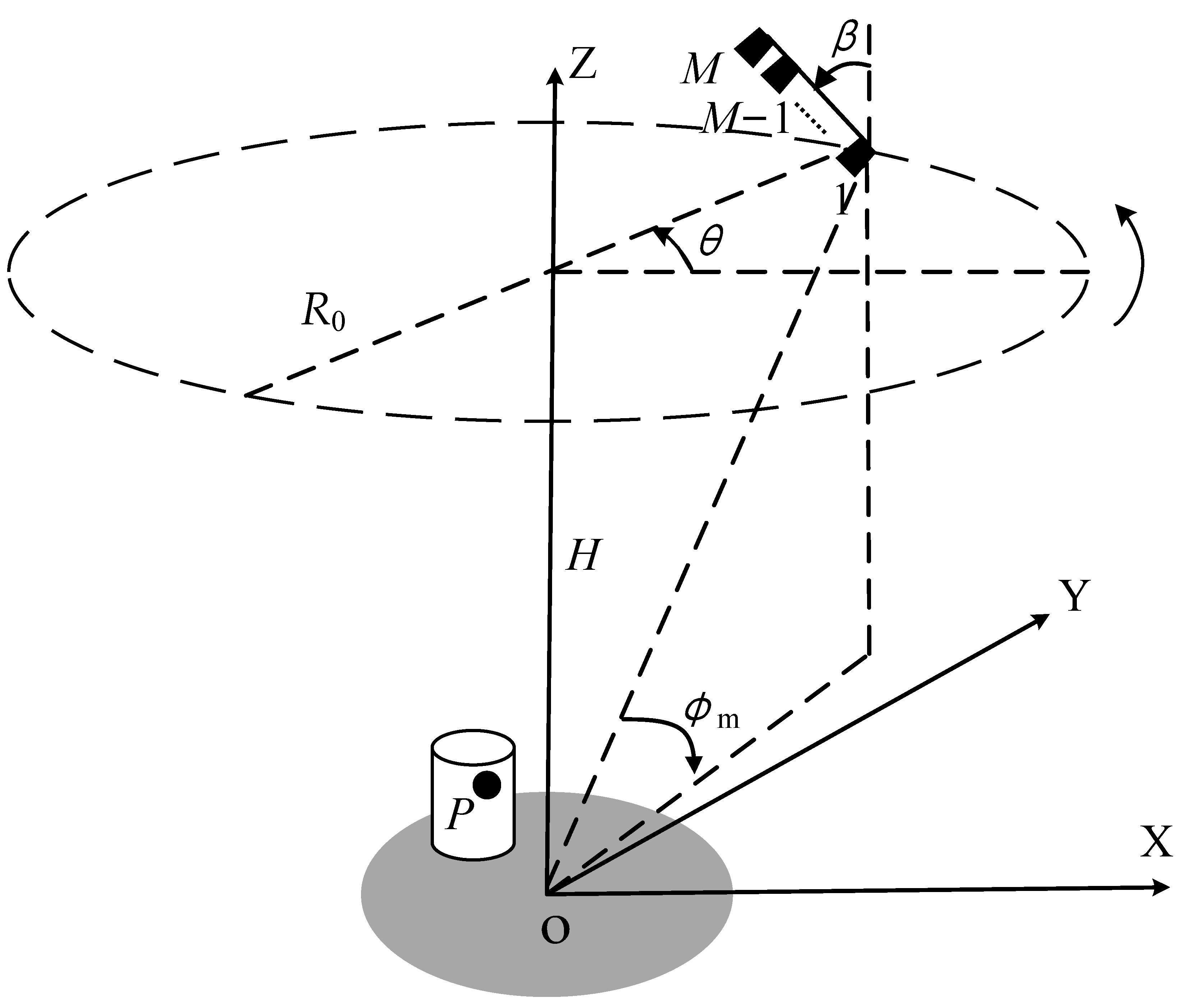
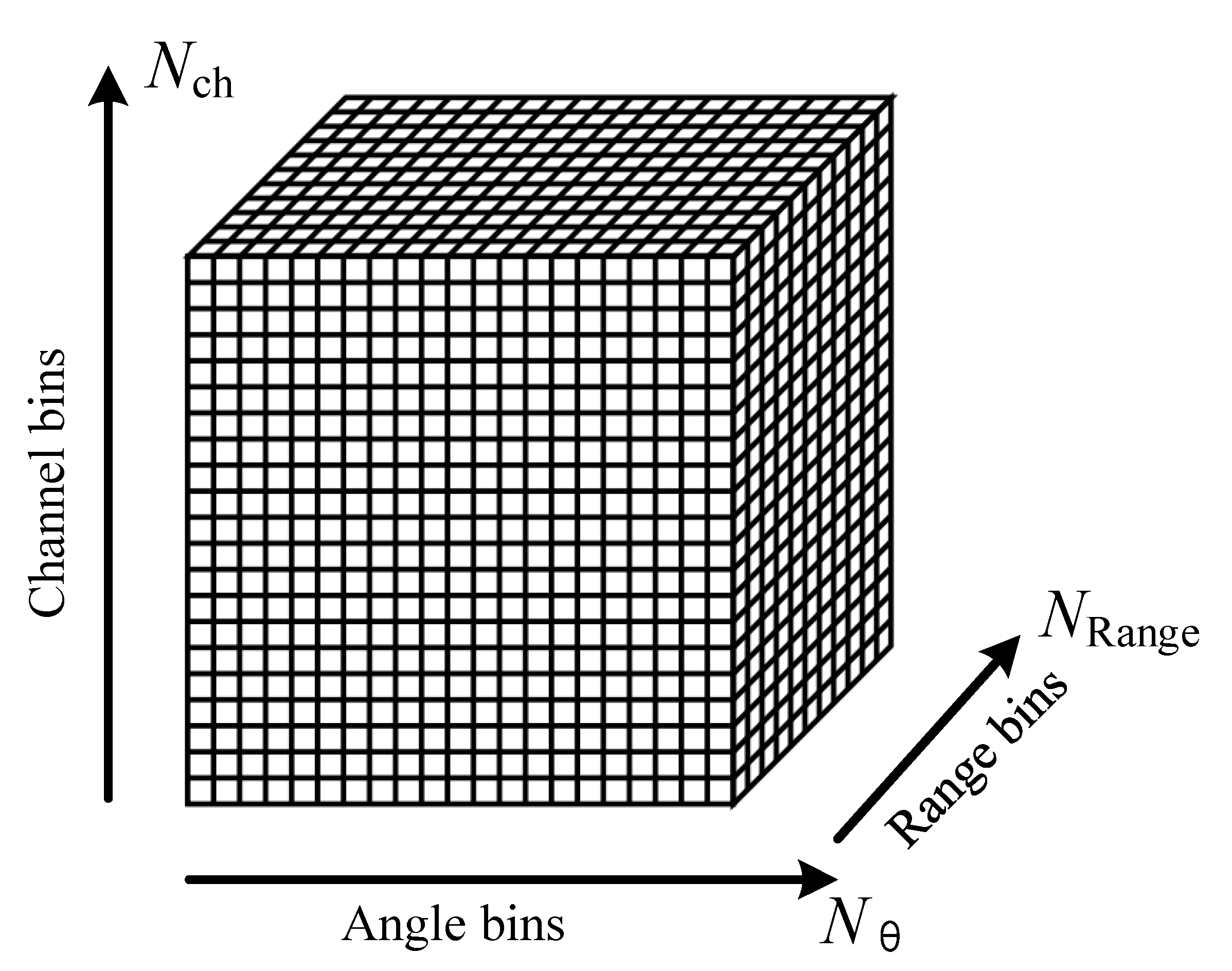

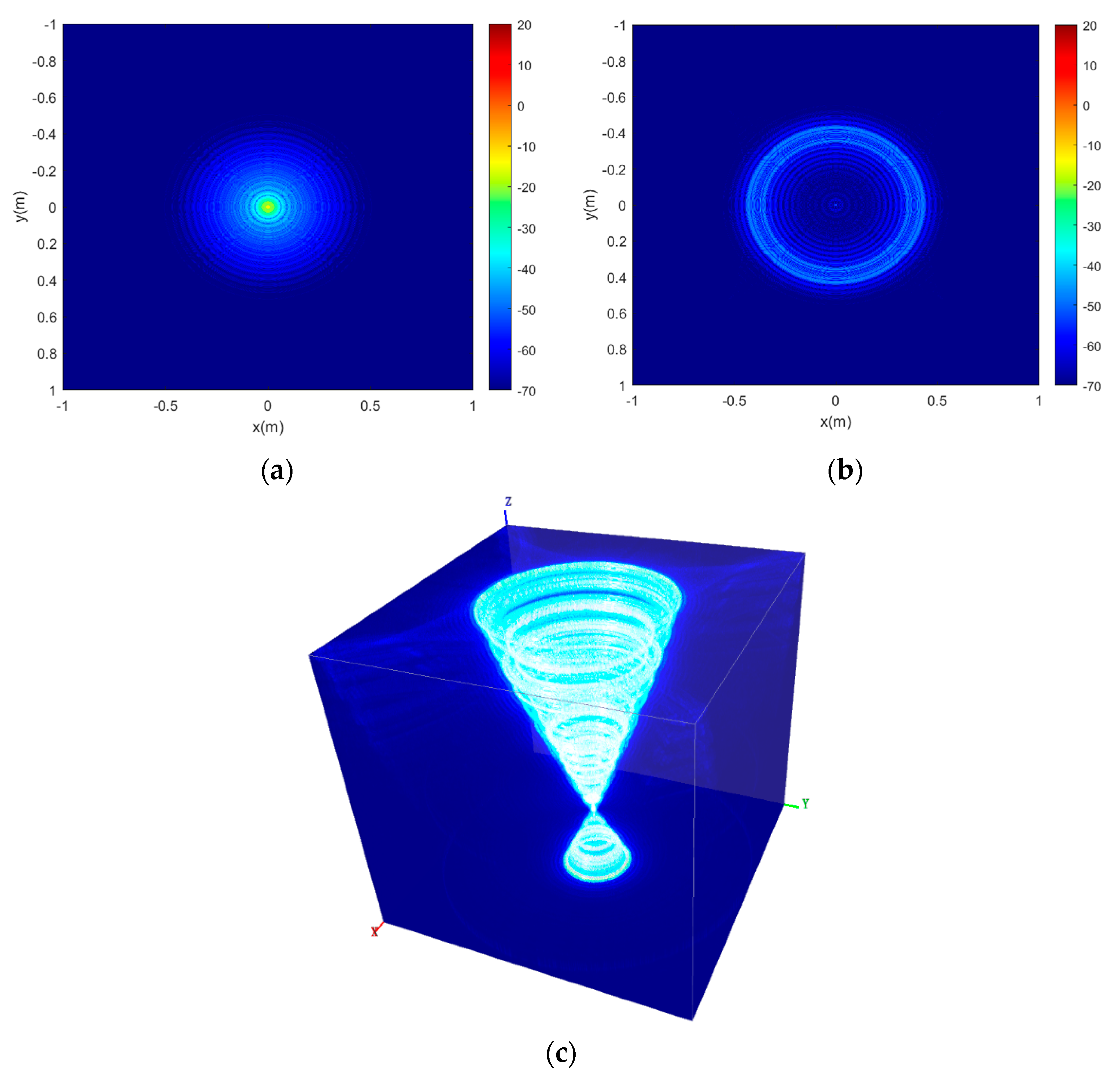
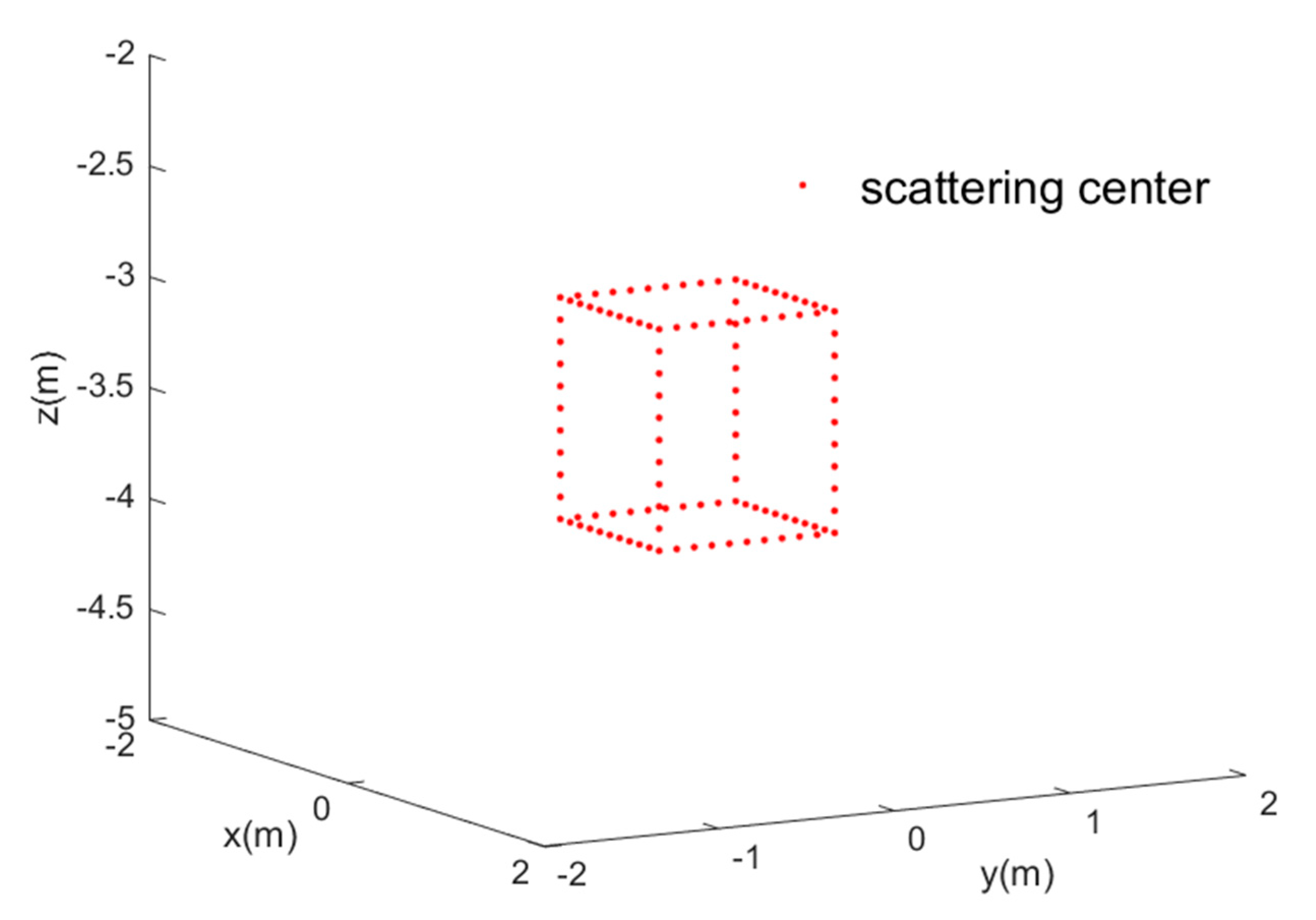
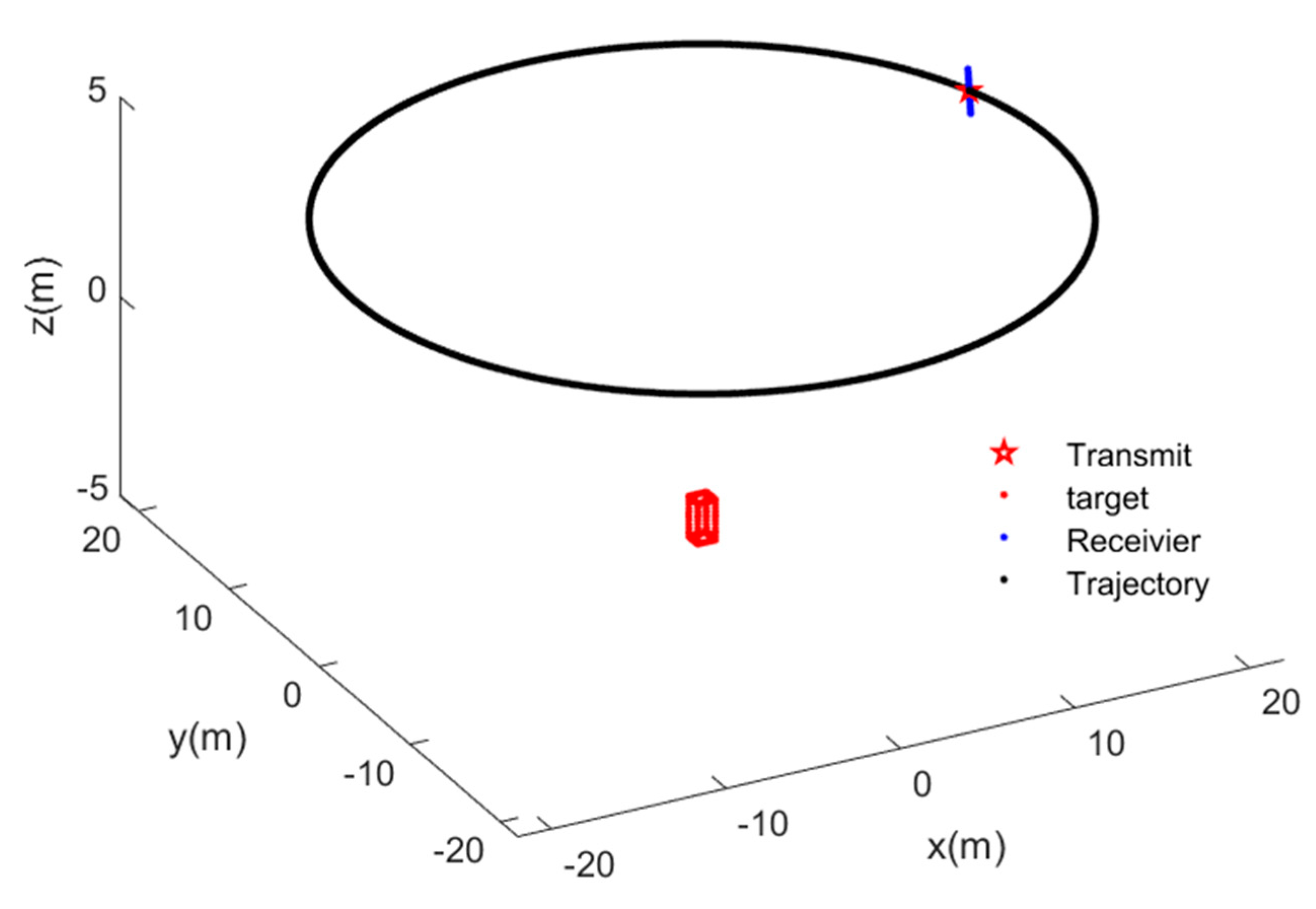

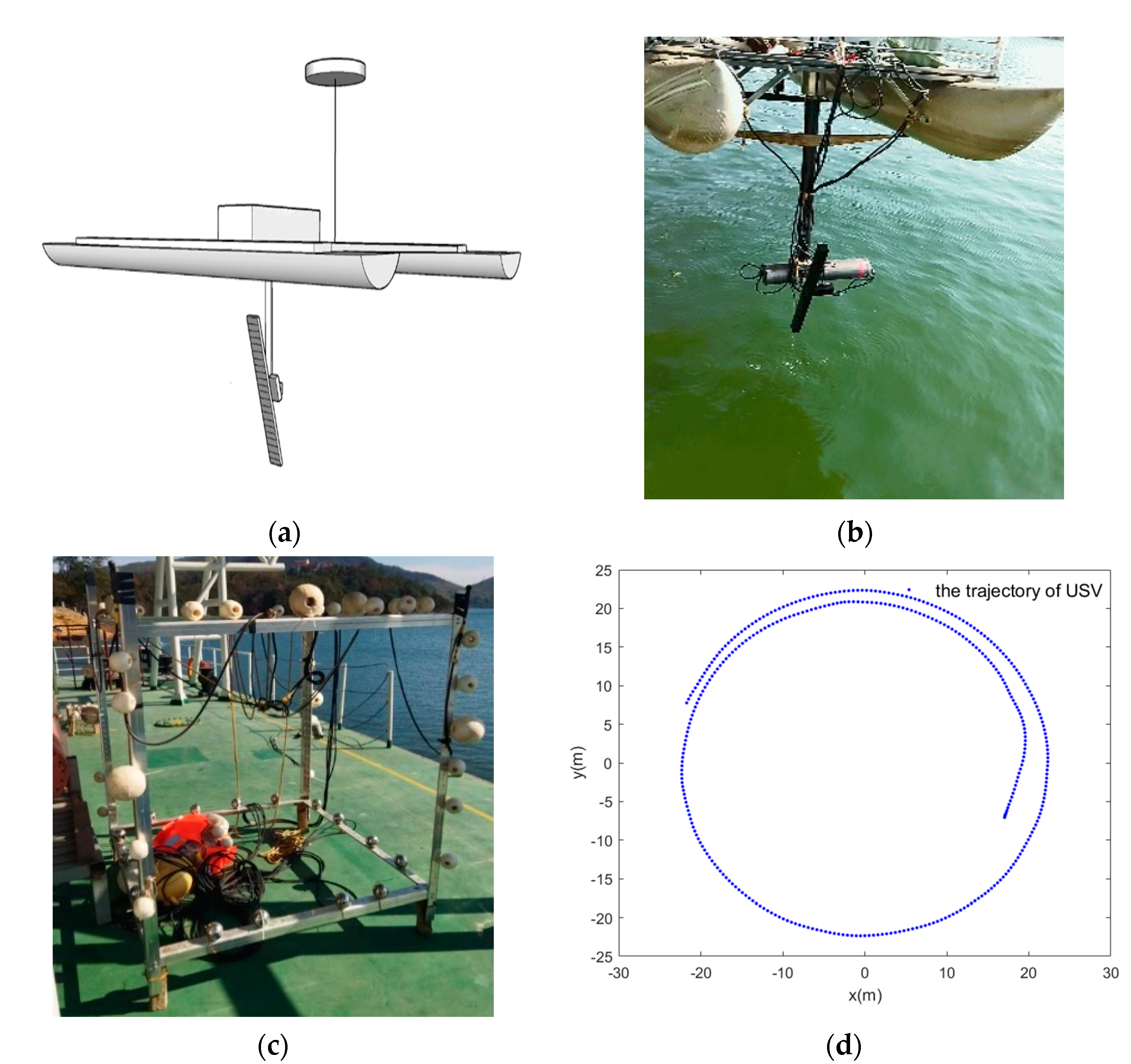

| Parameters | Values |
|---|---|
| Point coordinate | (0,0,0) |
| Height of CASAS system | 8 m |
| CASAS system Radius | 20 m |
| Angle to Z-axis of CASAS | 10° |
| Equivalent sensors | 32 |
| Center frequency | 100 kHz |
| Band | 30 kHz |
| Signal | LFM |
| Pulse duration time | 40 ms |
| Pulse width | 2 ms |
| Parameters | Values |
|---|---|
| 3D target | 1 m × 1 m × 1 m (it consists of 116 scattering centers) |
| Z-axis coordinate of 3D target Bottom | −4 m |
| Height of CASAS system | 4 m |
| CASAS system Radius | 20 m |
| Angle to Z-axis of CASAS | 10° |
| Equivalent sensors | 32 |
| Center frequency | 100 kHz |
| Bandwidth | 30 kHz |
| Signal | LFM |
| Pulse duration time | 40 ms |
| Pulse width | 2 ms |
| Angular sampling interval | 0.2° |
| Parameters | Values |
|---|---|
| Target | Steel cube 1.5 m × 1.5 m × 1.8 m |
| Target layout | At the bottom of lake |
| CASAS system Radius | ~25 m |
| Angle to Z-axis of CASAS | 10° |
| Equivalent sensors | 32 |
| Center frequency | 100 kHz |
| Band | 30 kHz |
| Array length of CASAS | 1.2 m |
| Distance of receiver | 2.5λ |
| Signal | LFM |
| Pulse duration time | 100 ms |
| Pulse width | 10 ms |
| Speed of USV | <1.5 kn |
| Navigation devices of USV | RTK GPS, INS, DVL |
Publisher’s Note: MDPI stays neutral with regard to jurisdictional claims in published maps and institutional affiliations. |
© 2022 by the authors. Licensee MDPI, Basel, Switzerland. This article is an open access article distributed under the terms and conditions of the Creative Commons Attribution (CC BY) license (https://creativecommons.org/licenses/by/4.0/).
Share and Cite
Zeng, S.; Fan, W.; Du, X. Three-Dimensional Imaging of Circular Array Synthetic Aperture Sonar for Unmanned Surface Vehicle. Sensors 2022, 22, 3797. https://doi.org/10.3390/s22103797
Zeng S, Fan W, Du X. Three-Dimensional Imaging of Circular Array Synthetic Aperture Sonar for Unmanned Surface Vehicle. Sensors. 2022; 22(10):3797. https://doi.org/10.3390/s22103797
Chicago/Turabian StyleZeng, Sai, Wei Fan, and Xuanmin Du. 2022. "Three-Dimensional Imaging of Circular Array Synthetic Aperture Sonar for Unmanned Surface Vehicle" Sensors 22, no. 10: 3797. https://doi.org/10.3390/s22103797






